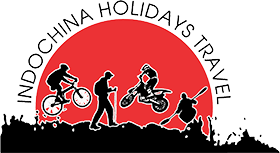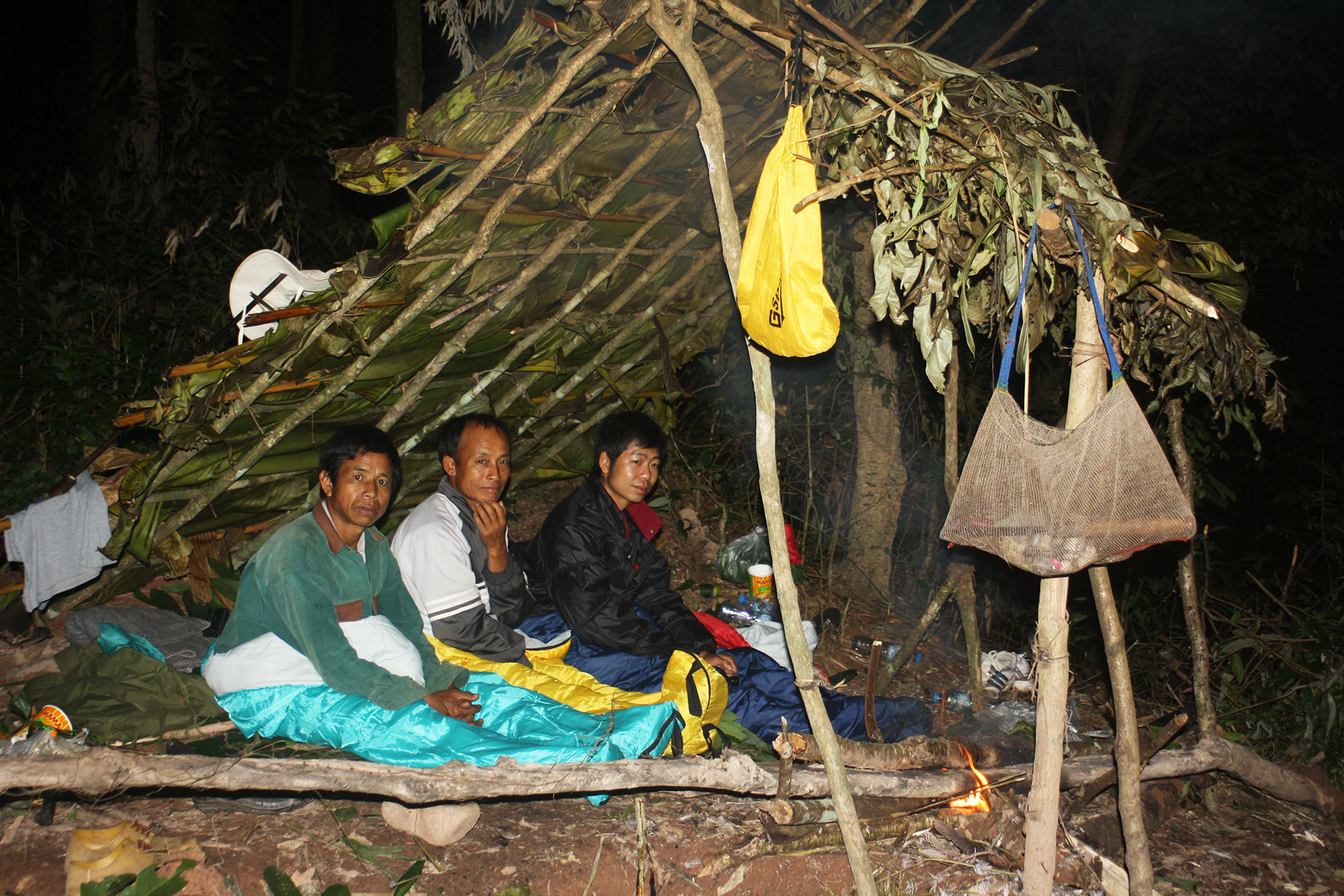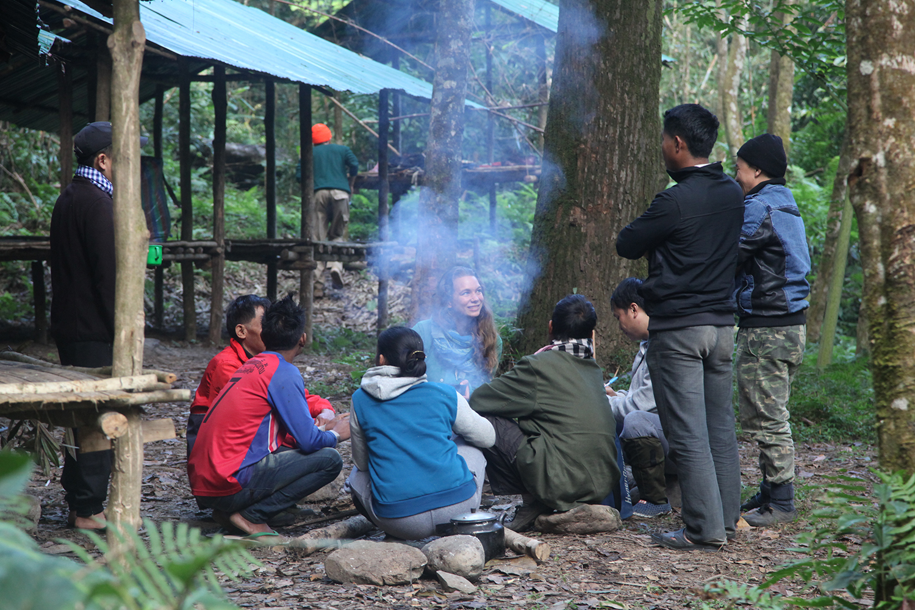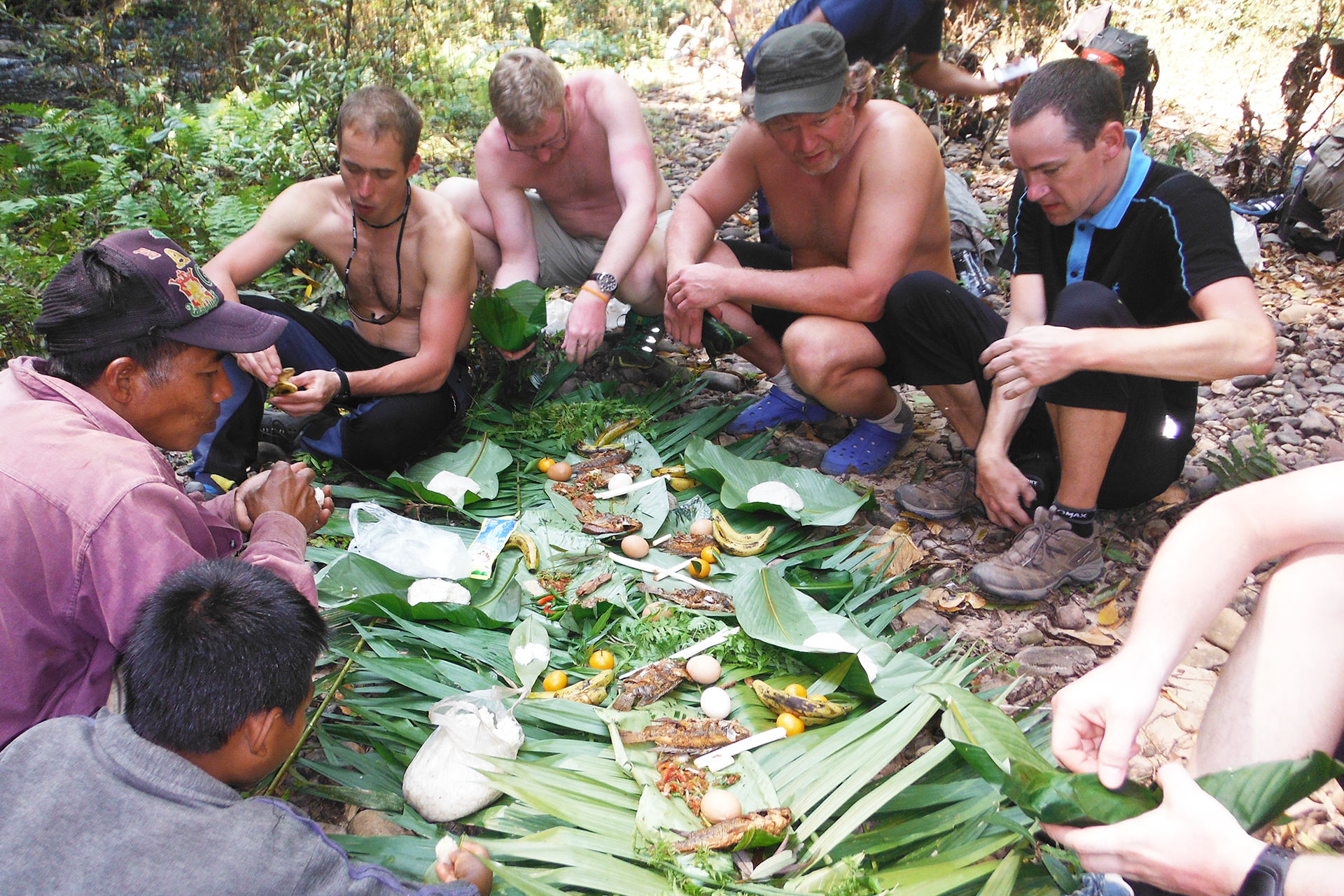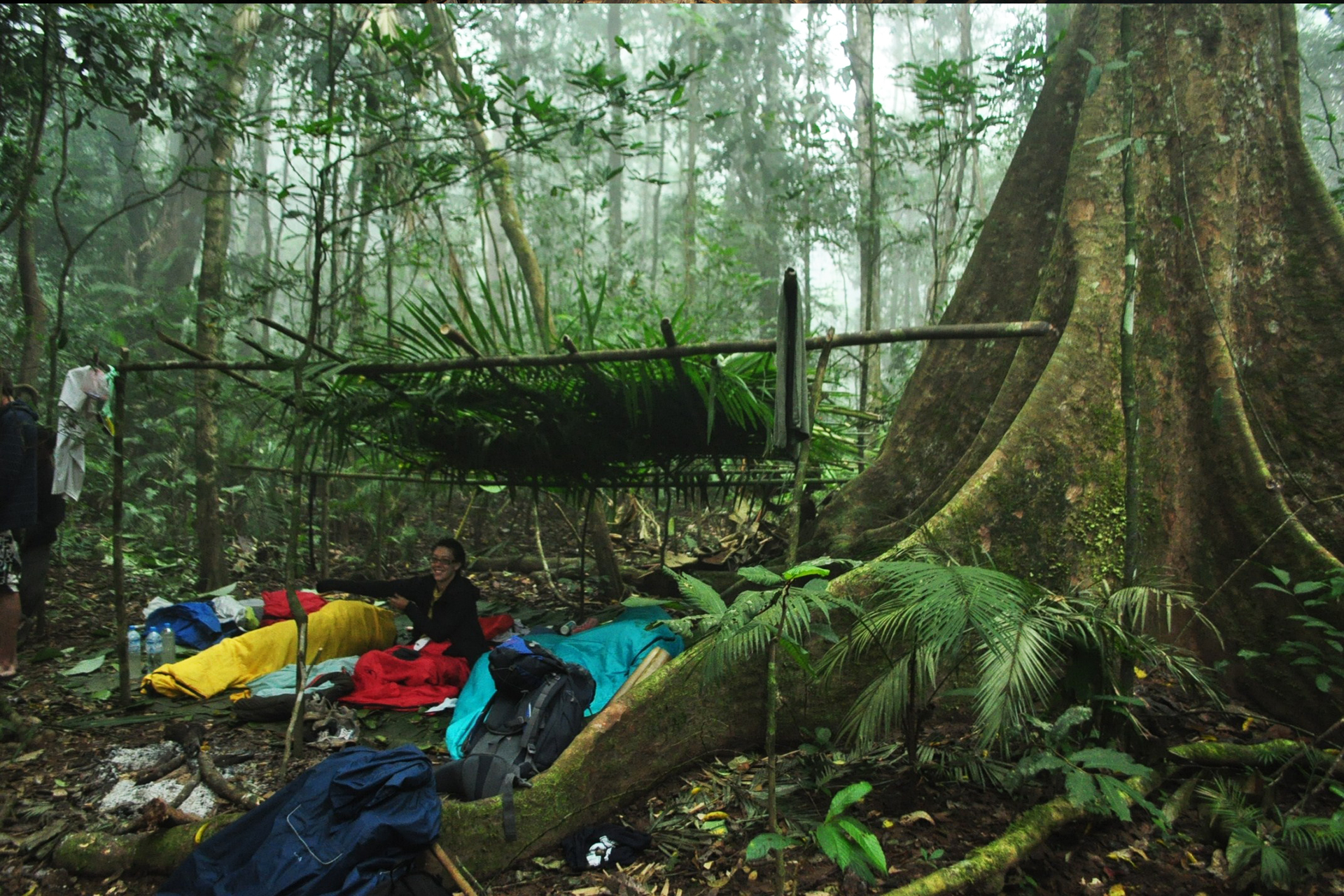Highlights: The first night overnight at the Akha Eco-Lodge, the second night at a Khmu homestay, the third night in a jungle camp and the late Khmu Homestay; Ethnic minorities as: Akha, Khmu & Lantén Tribes; Hike through Nam Ha River, mountains landscapes, jungle rain forest, follow a hunting trail, stunning views, hidden of waterfall etc; Nam Ha National Protected Area- an ASEAN Heritage Site; Awarded ASEAN Standard of Community Based Tourism 2018; Join tourism activities as local foods, traditional performant, rice husking, bamboo baskets, bamboo cup, bamboo cooking, blacksmith, archery etc.
Day 1: Ban Chaluernsouk-Ban Phou Varn “Akha Village”. Approx. 5-6 hours.
8:30 AM pick you up from your hotel in Luang Namtha by Tuk-Tuk. We stop for a few minutes at the morning market to purchases some food and necessary things, and then continue to the Khmu village of Ban Chaluernsouk where our trek begins. Hike deep into the Nam Ha National Protected Area. On the trail the local guides will share some of the native experience and knowledge about edible and poisonous plants, and about medicinal plants that include wild mushrooms, cardamoms, rattans, bamboo shoots, wild bananas stalks, and so on. After lunch, continue and visit waterfall, next hike to the mountaintop where you walk along through the agricultural area of the Akha people. On the mountain you will enjoy the excellent view of the Akha village amidst the dense jungle vegetation of the mountains. You will arrive at Ban Phou Varn (Akha village) around 4 PM. While your hosts and guides prepare your dinner you can either relax, help in cooking while learning about the traditional cooking cuisine, walk around the village observing traditional life, or have a beer at the local ‘shop’. After dinner you receive a massage from the Akha women, this is a treat traditionally reserved for guests in the village.
Day 2: Ban Phou Varn-Ban Nam Ha “Khmu Home stay”. Approx. 5-6 hours.
After breakfast we begin the next leg of the journey over a small path through the rain forest, which is still primary and secondary forest area. After approx. 3 hours we have our lunch break, which will be prepared by you and your guides. Thereafter another 3 hours walk along the Nam Ha Mountain and downhill to Ban Nam Ha village. That is the village where we will stay overnight and share in tourism oriented activities. You will join in and try out some activities created by a small native community that is now part of a community based tourism village and will show and teach you skills, such as: husking rice by feet or hand, a Khmu traditional Baci-ceremony, Khmu sword dance… After dinner you may want to listen to a village story from the home stay owner before you go to sleep in the Khmu traditional house.
Day 3: Ban Nam Ha-Mountain Jungle Camp. Approx. 5-6 hours.
Next morning after coffee you may see or participate in activities such as: blacksmith at work, weaving bamboo baskets or making gadgets/toys/souvenirs from bamboo, such as: birds, frogs, a simple cup, etc. Then have breakfast with the host family. Next local guide from the village will join on your trip to get you safely through rice paddies and up into the mountains of Nam Ha NPA. Along the trail you will see many types of NTPs (Non Timber Forest Products), many bird species, monkeys are occasionally spotted or heard; your guide will teach you how to make a bird call, or bark like a deer, mimic squirrel sounds. They will also share some of their ancestral knowledge and skills about traditional medicines. Lunch is eaten in the shade near the waterway, after you will arrive in the jungle camp around 4 PM. Over there it makes for easy walking in the jungle, very near the forest camp. You will follow the trail, search for animal footprints and other elements that point to the forest wildlife present, such as: monkeys, barking deer, gibbons, wild pigs, and jungle fowl. The guide will point out interesting things and useful plants, used as herbal medicine like cardamoms, galangals. After dinner you overnight in the rain forest camp hosted by Khmu people.
Day 4: Mountain Jungle Camp-Khmu Village. Approx. 5-6 hours.
In the early morning you will many an animals scream from the higher mountain and nearly the jungle camp. The guides will encourage you to take part in the preparation of breakfast, show you how to craft simple coffee cups, bamboo toys, spoons and chopsticks from bamboo and leaves. They will also brew a medicinal tea from wild plants collected along the way. After breakfast we walk on through jungle, mountains and over rivers. Lunch will be prepared in the traditional native way along the forest path. We will arrive Ban Nalan around 4:00 PM where we spend one more night in the Khmu’s Riverside Eco-Lodge. Our hosts prepare a dinner in native style, whilst you take time to swim and bathe in the river (no nudity or skimpy clothes, please). Walk around the village; talk respectfully with the ever-friendly villagers.
Day 5: Ban Nalan-Ban Namkoy-Ban Namlue. Approx. 5-6 hours.
The last day follows the Nam Ha River, through stands of large hardwood trees and bamboo patches, to Ban Nalan Tai (Khmu Village) and Ban Namkoy (Lanten Villae). The trail becomes quite challenging as it climbs under a pristine tree canopy teeming with bird life, and ends up on a ridge with a stunning view of Luang Namtha town, visit the last village of Lanten (Ban Namlue), that is, before the final descent and a ride back to town with memories to will last you a lifetime.Drop you at your hotel . End the tour .
Tour price: Contact us
Group size: 2 to 25 Pax
Departure date based on your inquiry
Price Includes:
- English speaking tour guide
- Local guide from the Khmu village
- Transportation from your hotel & back to hotel
- Accommodation (Akha-Eco-lodge, 2 Mountain Jungle Camps & Khmu Homestay)
- Meals (13 meals covered) “Local food or Jungle style”
- Drinking water during the trip
- Nam Ha National Protected Area Fee
- Community distribution
- Government Taxes and charges
Extra info
More Information about Treks
Do I have to be very fit to do a trek?
For the first day we have to trek 4-6 hours include relaxing along the trail. No transfers for pick up who can’t trek. If you can’t trek on the second day that we can use kayaks travel along the Nam Ha River. For the longer treks you need to be reasonably fit, but a lot depends on your own flexibility. You will not sleep as well as usual because of the primitive way of sleeping and the sounds of the village.
In the jungle
During the trek there will be hardly any flat parts. All the paths are used by the local people. Sometimes the path is overgrown, and the guide has to use his machete. We walk through dense jungle of Nam Ha National Protected Area, before arrival village we will walk through open areas, plantations of the hill tribes and sometimes along or through rivers. If you want, you can hire a porter to carry your luggage.
Akha Eco-lodge
Akha Eco-lodge is the guesthouse made by Akha people to welcome guests who stay overnight in the village, the Eco-lodge design look same Akha’s house style some made by bamboo and woods. the Eco-lodge are shared room include provided blanket, sleeping-mat & mosquito nets and toilet. Participants must be aware that there are no western-style toilets and washing facilities.
Khmu Homestay
All Khmu homestay in the village have been passed Luang Namtha Homestay Standard and ASEAN Community Based Tourism Standard. Homestay design look same Khmu’s house style some made by bamboo and woods. Each room in homestay include mattress, blanket, mosquito net, towel, pillows with clean toilet in outside.
Riverside & Jungle Camps
Built up by local people of Nam Ha & Nalan Village (Khmu tribes) who will serve your service when you stay overnight there. The camp very basic made by woods and bamboo located on the bank of Nam Ha river. The camp will provide sleeping bag and mosquito net.
For the jungle camp will build up when you arrive that area by local guides that you can join with them. you will be sleeping on the ground cover by leaves and roof by banana leaves. Sleeping bag and mosquito net will prepare for you. If you need sheet bag, we have but you have to bring from our office. If you need tents please tell us advance.
Village Passing
Ban Phou Varn Akha Village is located on the top of the mountain in Nam Ha NPA where you will see stunning view around the village. They have lived here for a long time and still unique in terms of culture. In the village your will learn about Akha lifestyle, culture, and traditions. The village started tourism since 2005. In the village they offer Eco-lodge, local foods, local guides, and Akha massage etc.
Ban Nam Ha Khmu Village located along the Nam Ha Rive. The village started Community based tourism since 2010. It was developed in response to preserve natures, cultures and as an alternative source of income for local villagers. As poverty is still a main problem in the area, there is a need to generate jobs and income for villagers to prevent them from illegal forest encroachment. Present they offer group of husking rice, black smith, making bamboo basket, Khmu traditional Baci-ceremony, sword dance, short trek through jungle forest & participate in the day-to-day work of the family.
Ban Nalan Khmu Village the village award ASEAN Standard of Community Based Tourism 2018, where your will learn about Khmu lifestyle, culture, and traditions. The village started tourism since 1999 that you know Nam Ha Ecotourism the first project in Laos PDR. In the village they offer homestay, local foods, local guides and many activities as traditional performant, rice husking, bamboo baskets, bamboo cup, blacksmith, archery and etc.
When is the best time to do a trek?
This is very hard to say. During the Laos winter, from November to February (the high season), the weather is the best (not to warm in the daytime, no rain and cool to cold in the nighttime). During the summer (March to May) it will be very hot in the daytime but there are few tourists. During the rainy season (July to September) the nature is at its most beautiful with green forests and beautiful natures. Walking can be hard sometimes after or during a tropical shower.
What you should bring on a trek
Sleeping bag (in winter) or sheet bag (in summer), mosquito net (only for sleeping in the camps the local guide will bring for you. No need if you overnight homestay in the village), small backpack, T-shirt, short pants, long pants, towel or sarong, pair of socks, long sleeve shirt, pair of slippers, pair of shoes, swimsuit, soap, shampoo, toothbrush /toothpaste, mosquito spray, sun cream, flash light, 2 liter drinking water for the first day (buy at day 1 first stop) , hat or cap, first aid kit, toilet roll
Extra in Rainy Season (June-October) = Raincoat and Hiking Boots
Extra in Cold Season (November-February) = (Jacket and Warm Pants)
The luggage you do not take on the trek you can leave in the store room at your hotel or our office as well as passport, ticket and travelers cheques which they will put in their safe. Good hiking boots are essential in the rainy season but also very handy in the other months. You can buy water in the villages.
In the mountains it is a few degrees cooler than in Luang Namtha town. During winter it can even be cold, a few degrees Celsius above Zero. Please remember this when you do a trek during this time.
What you should NOT take on a trek
Passport, Flight ticket and Travelers Cheques. Whenever you lose your passport you have to go to Vientiane to get a new one. Also, a tropical shower can reduce your precious papers to something else. At the safe in your hotel your belongings will be safe!
Make sure that your photo or film camera is packed water proof, nature here is unpredictable
Candies for the children would be nice but they usually can’t go to the dentist easily. A donation for the village or village school is a better idea.
Bank notes in high denominations will be a problem changing them in smaller ones
Optional:
- Snacks, fruit, your own bottle of water
- Your own medicine if you need it
- Sandals
- Flip-flops
Other:
- Please let us know in advance if you are vegetarian
- Please be at our office at 8:00 am
- You are welcome to contact us beforehand if you have any questions
Important Do’s & Don’ts:
- Do not give individual gifts of sweets or money to children
- Ask before taking photos of people or spiritual items
- Help keep the trails clean by not littering
- Please purchase handicrafts but do not purchase antiques
- Do not remove any archeological remains from the site of the ancient temples
- Always stay with the guides
- Do not use drugs
